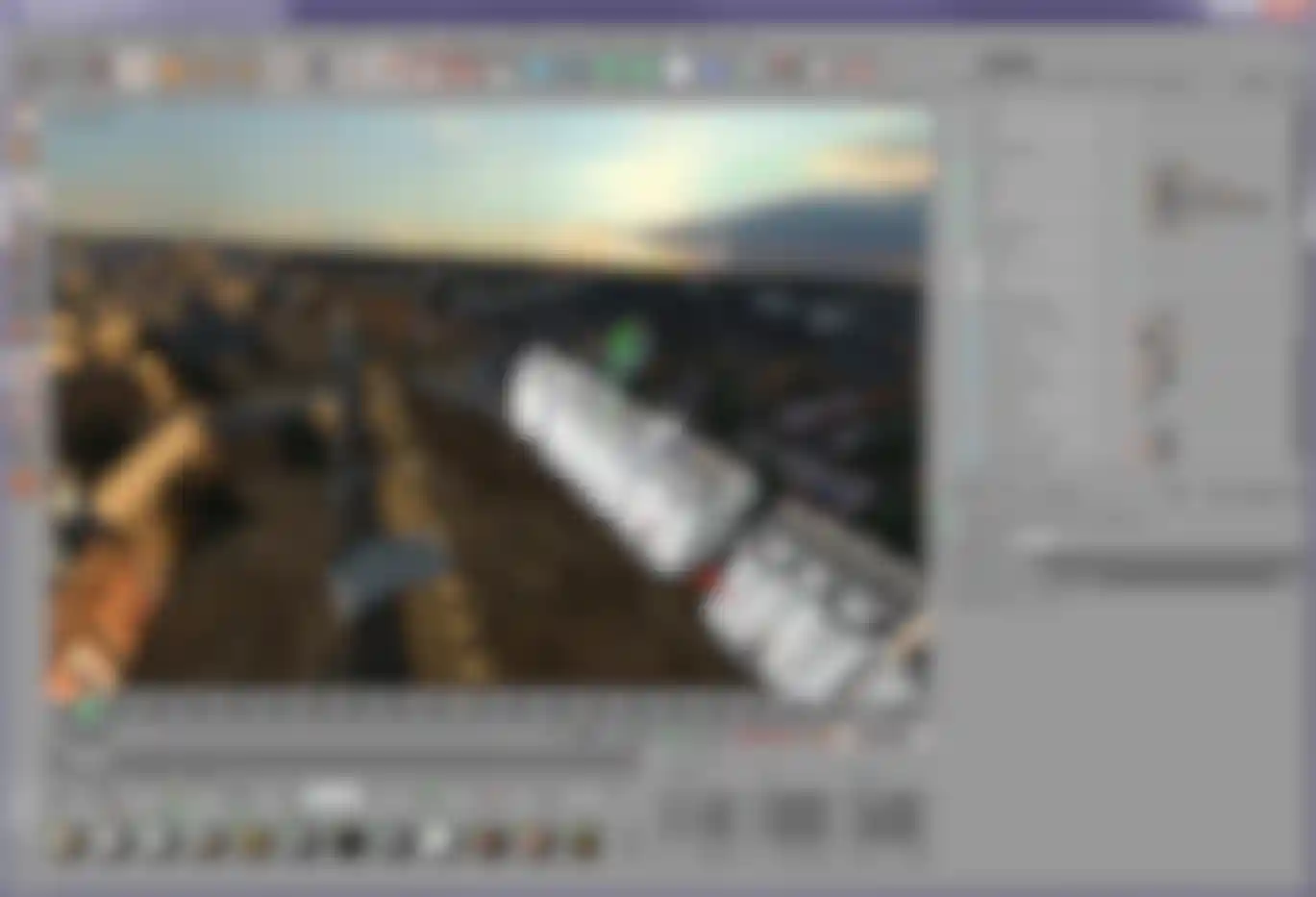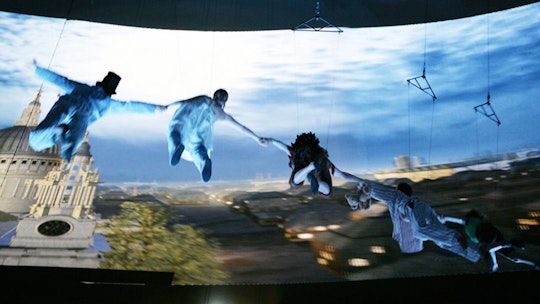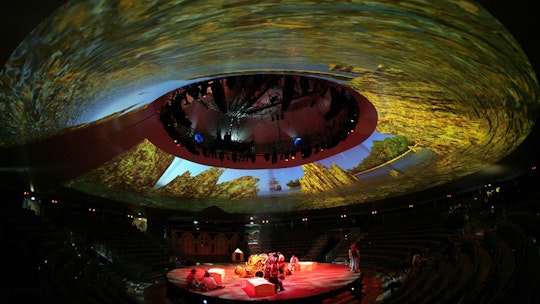
Cinema 4D Helps Audiences Fly to Neverland How William Dudley used Maxon's Cinema 4D to create dazzling CG imagery for the world's first fully 360-degree projected animated stage set in a new production of Peter Pan.
To bring J.M. Burrie's Peter Pan to life on the world's first 360-degree projected animated stage, renowned theatre designer William Dudley turned to Maxon's Cinema 4D. Performed "in the round" on The threesixty˚ Theatre pavilion, Peter Pan immerses cast and audience alike in a CGI Neverland thanks to virtual and physical sets designed with Cinema 4D's fast and efficient modeling, texture, lighting and rendering capabilities.
The stage production relies heavily on a custom-built tent designed by Teresa Hoskyns, whose architectural design credits include Cirque Du Soleil. Featuring seating for 1,350 persons, the 99% light-tight structure is suspended by external girders, affording every member of the audience a fully unobstructed view of the stage, which includes the center pavilion as well as its upper walls. The walls serve as a gigantic surround projection screen, bringing projected 360-degree CGI imagery to live theater audiences for the first time.
The dazzling cinematic-style animation, created by Dudley, Matthew "Mash" O'Neill and a small team of CG artists with Cinema 4D, seamlessly blends with live actors and physical props. The result is a surprisingly intimate immersive experience that Dudley calls, "cinematic theatre."




High-efficiency workflow
A dazzling flyover of Edwardian London gives audiences their first taste of the immersive CGI used throughout the threesixty˚ Theatre production of Peter Pan. To create the enormous cityscape, Dudley and O'Neill started with a map of London, circa 1900. "We mapped out a great big flight path, which included a number of very recognizable landmarks, including Big Ben, Buckingham Palace and Nelson's Column in Trafalgar Square." The primary concern was keeping a model of 400 square miles of London efficient enough to fit within the 16 gigabytes of RAM they had to work with and still deliver a level of detail that produced a believable experience. They pulled it off using Cinema 4D's robust polygon and HyperNurbs subdivision surface modeling tools as well as a lot of camera mapping. "Tower Bridge," O'Neill explains, "consists of basic geometry with a nicely lit nighttime photo of the Bridge mapped onto it and motion blur added to the final render."
Dudley modeled some of the more notable landmarks, including St. Paul's Cathedral. That particular highly detailed model, however, weighed in at 40 million polys — well over the 15 million-poly budget for the entire flyover scene. To reduce the polygon count, O'Neill used Cinema 4D's texture baking feature to render the detail and project it on a plane aligned to the camera. While they held the polygon count down to 15 million, the 8.5K image files still took 200 computers four weeks to render.
In addition to flying over London, Peter Pan takes audiences on a magical journey through clouds and jungle, under water, on the deck of a pirate ship and under ground. Clouds were created using Cinema 4D's PyroCluster volumetric shading system, Thinking Particles — Cinema 4D's particle system — and the MoGraph 2 animation effects module. To cover Neverland Island in palm trees, the team put Cinema 4D's hair system to use, replacing each hair with a palm tree model that could be "brushed" into place. The cloth system included in Cinema 4D's character animation system handled flags blowing in the wind and sails on the pirate ship.
Projecting CGI in the round
Figuring out how to visualize on computer monitors animations that were going to be projected in 360 degrees took some experimentation. Various techniques were tried before they discovered a plug-in called WFcam, short for Wide-Field Camera. "It's designed to produce fisheye lens distortion effects," O'Neill explains. "We were able to get it to render 360-degree panoramas by cranking up its settings, but that meant we had to use the best anti-aliasing settings."
About halfway through the production, O'Neill and Dudley discovered the DeGamma plug-in, by Per-Anders Edwards. "It allowed us to render a lot quicker in 360 degrees," O'Neill says.
Transitions
Handling transitions between scenes in movies has a well-established vocabulary, consisting of things like wipes, cross-dissolves and simple cuts. Live theater usually relies on things like curtains dropping or backdrops and sets changing. For Peter Pan, the stage is set in the round, so there is no curtain to drop. Instead, props rotate out of sight below the stage and, in the case of the CGI scenes, wipes transport the audience from one environment to another. One of the more striking transitions occurs when the scene shifts from above water to below.

To accomplish this, "we rendered two animations," O'Neill explains. "One with the camera moving downwards above water and another where the camera moves downwards below water. And then we rendered out this great big wavy-shaped alpha matte to wipe between them in After Effects."
When it came to the transition between the physical and the virtual, the lines were intentionally blurred. Dudley explains, "Youth today expect a multimedia experience at live events. Many details of the theatrical stage sets in Peter Pan were designed with young audiences in mind — live actors in costume are interacting with both physical props and cinematic CGI in illusionistic 3D space, on the ground and aerially, further blurring the lines between theatre and cinema."
How did they match the lighting in the CGI to the physical sets' lighting? "It was more the other way around," O'Neill says. "We would do the video and then the lighting director would essentially work around us. It was the same for a lot of the production, actually."
That particular workflow was dictated by their budget, which accommodated a single final render of the video. While this put a lot of pressure on the team to get it right the first time, Cinema 4D let them proceed with confidence. "Frankly, it's one of the reasons we used Cinema 4D," says O'Neill. "When I render in Cinema 4D, I know that what I see in the render port is what I'm going to get from the final render. There's no monkeying around with third party software and exporters and bridge software. It's just hit a button and there you go. You're done."
Many more iterative changes were made during the early stages of designing the physical and virtual sets. Dudley explains, "Fabricating extremely detailed physical working models is costly and subject to endless revision and change by the director. Using Cinema 4D permitted us to model, texture, light and animate complex, timed scene changes, and distribute copies of plans and stills to numerous technicians and contractors as well as make adjustments for fine details or specific views of the set quickly and efficiently. The orthogonal views in the software were especially useful in generating technical drawings that can show multiple renders of a stage prop for maximum clarity of intent."
Peter Pan by the Numbers
- 12 20K BARCO projectors deliver 360-degree projection
- CG animation stored as MPEG-2 runs at 50 fps, at a resolution of 11,790,00 pixels per frame
- 12 screens surround the audience and measure 46 x 33 feet each
- The tent stands 100 feet tall and its cupola holds 10 tons of light, sound and air conditioning equipment
- Three 110-foot tall girders are used to suspend the threesixty˚ Theatre pavilion
- It took a team of 5 CG artists 10 months to create the virtual environments
- 200 computers took 4 weeks to render the CG imagery














